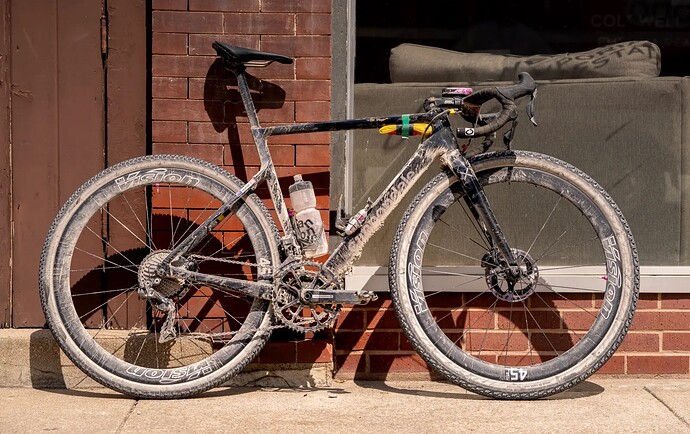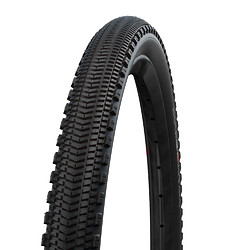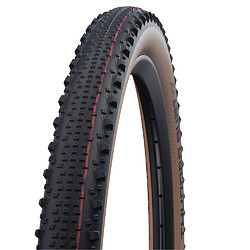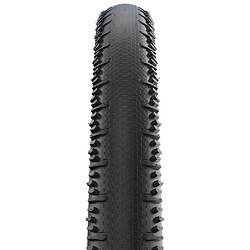Personally, I would take Dylan more seriously if he didn’t give off that “bro I’m better than you attitude” & also didn’t have questionable takes on women’s cycling. But, yes there was also some advantages to his tire choice too.
In a similar vein, I was really interested to hear what Lachlan Morton had to say about his Unbound setup in the latest Performance Process podcast.
Quick summary of what I can recall (could be mis-remembering bits) - he thinks that gravel bikes should continue getting longer with slacker front ends and steeper seat tubes. He finds a long, low posture to be more comfortable on long days. And seems to agree that fitting as much tire as possible is the way to go.
Did he say how wide he likes or if he prefers 27.5/650b or 29er/700? Cause I’ve been enjoying 27.5x2.6 tires as well as 29x2.25 on drop bar bike for gravel. The smooth routes get the G-One in 29x2.25 and the chunky routes get the Mezcal 27.5x2.6, But, I really want the Ultra Dynamico Mars in that size with a Rose in the rear. I wonder what handlebar size he runs.
Cheers for the intel.
Been pondering what to do about brakes for a hypothetical drop bar bike, but I am a total hydro snob ![]() nothing but bad experiences with cable and hybrid disc brake setups.
nothing but bad experiences with cable and hybrid disc brake setups.
There are a pair of TRP hooded hydro levers and callipers that look interesting. Anybody tried these?
He was talking about running I think it was 700c x 50mm up front and 44mm in the rear just based on what tires he had access to and his frame clearance.
No worries. All I can say is don’t knock ‘em till you try them. I’ve had a lot of people who are Klamper curious try my bikes a most seem impressed with how the feel.
Also, no experience with those particles TRP brakes but great experience with their MTB lineup (Quadiem / Trail EVO / DH-R EVO). I’d say you should give them a go and report back here haha.
Hope RX4 brakes looks real cool too and it’s 4 pot. The other week on reddit I saw a redditor running 4 pot shimano brakes on his grx setup. I got a buddy who has Magura calipers off a Campy setup on his Ultegra RX equipped all road bike and that’s been real sweet looking too.
Related question and hot take. For gravel-mtb cross overs/monstercross bikes, what sta is better. Something more gravel-ish at 71.5-73° similar to how Tanglefooot does it on the aforementioned Hardtack or more mtb like at 74°-76° like the Stigmata and a few other models? Does 1° make a significant enough difference? I doubt half a degree does.
what sta is better
I think that’s a pretty impossible question to answer, especially since STA is kind of a non-driving dimension in terms of bike fit. STA determines if you can get the saddle in the right spot but doesn’t actually determine where it is in space.
In broad strokes, people tend to prefer saddles further back (think slacker STA) for more upright bikes and saddles further forward (think steeper STA) for more “aggressive” positions. A setback seatpost will net about a 1-2º reduction in effective STA so that’s always an option if the fit is too steep.
My personal preference is moving towards the steeper side of things, I run 74º with a 0mm offset post on my road and gravel bikes. With a bit of nose-down tilt (not as much as Lachlan!) it feels pretty good to maintain the modern aerodynamic position for long races.
If you’re interested in learning more about this, the Performance Process episode A saddle position for more power and comfort is worth a listen. I think it’s subscribers-only but it’s worth giving Escape Collective some $ if you’re not already ![]()
Sounds like there are a few fun pick’n’mix combos that work well. I was more thinking about finding some drop-bar hydro brake levers without the shifting guts… thinking about an ‘all-road’ bike with friction shifting just for the flexibility and irrelevance!
I’ve used the latest mechanical Apex brifters on a Pinion bike. You can leave the shifter lever attached but I have cut it off for that sweet minimalist look. Big advantage over a lot of other non shifting levers is the ergonomics. Nice beefy hoods and brake levers that work very well with more rough riding.
Thank you for the reply. I will have to check out that episode out when I can. Been right now catching up on the all bodies on bike podcast, which is just a positive joy.
My point is you can get various type of brakes with those hylex if it is mineral oil based. So you could get some stronger brake combos with friction shifting.
Since this is the hot takes thread I’m gonna go out and say that 4-pot brakes are fairly pointless on a gravel bike (or anything but an aggressive MTB/heavy cargo bike). Without the grip of a proper MTB tyre that much braking power just means you just lose traction more easily.
But, wouldn’t it be good on a steep gravel downhill? Like I know a few fire road near me that is around 25%. Maybe 4 pot front and 2 pot rear? I do run grippy gravel tires like the UD Mars in the past and fast xc tires like the Mezcal for those routes
With drop bars? I just can’t see needing the power in that type of riding position. Maybe with flat bars but then ya just mountain biking.
In that case I would go for bigger discs to aid in cooling.
Slightly off topic but this is something I’ve thought about before and I want to see if others have opinions on this.
People occasionally spec a more powerful brake setup on the front wheel, either a larger rotor or more powerful piston. On cars this makes sense. Under braking, inertia is pushing the weight of the vehicle forward, causing the front brakes to have to work harder.
On a bicycle, at least 75% of the weight of the system is the rider. In hard braking, the rider usually shifts their weight back to keep their balance on the bike. In this specific scenario it seems to me like a more powerful front brake would not be necessary. Maybe if the rider brakes hard when seated the mismatched brake combo would be beneficial, but this isn’t the optimal way to brake anyway.
Curious what people think about this.
I was thinking about this the other day too. I think braking in the 2000-2010’s was limited by traction. But tires have gotten more volume and grippier, and bikes have gotten more supple suspension. You can grab more rear brake without the bike skidding. Also, because of the long front centers of modern mountain bikes, bikes have naturally more rear bias.
On my mountain bikes, I used to run a faster-rolling tire and smaller rotor. But now, I run the same tires and rotors front and rear to get more control when braking.
Tangeting back: Rolling resistance
Bicycle Rolling resistance has added mountain and gravel tires to the dataset.
Comparing 50mm gravel tires to fast rolling 2.2in+ mtb tires, It confirms what other people have mentioned in this thread about what pros ran at Unbound.
However, I was surprised by the big differences.
The Schwalbe G-one overland 700x50 was 20watts at 28psi:
The Schwalbe Thunderburt 29x2.25 was 16watts at 25psi!
Looking at those two tires, I would never have guessed the difference was 25% more rolling resistance
If you compare it to a “normal width” gravel tire, the Schwalbe G-one RS 700x40. It comes in at ~15watts at ~40psi (which is where I would run it).
I got some more insight from this world cup XC tire setup article on pink bike:
Most racers are running the widest tire, widest rim, and lowest pressure possible.
I have had TRP Spyre calipers forever on my cyclocross bike. Absolutely maintenance free for years. Cheap also.




